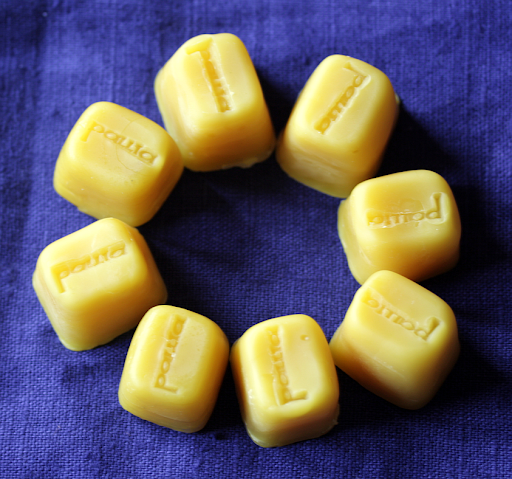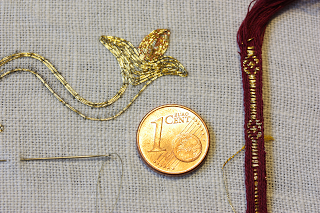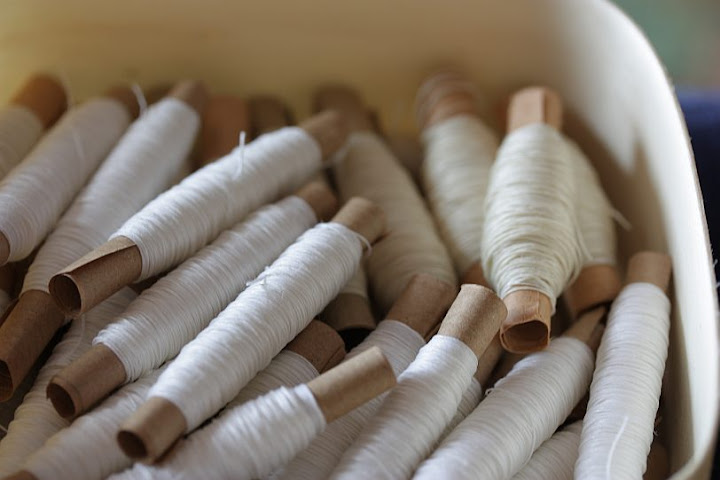For a change, here are some thoughts about the book I currently read. The full title of Mary Beaudry's work is "Findings. The Material Culture of Needlework and Sewing", and of course, a title like this seriously incites my interest.
The book aims to give an overview of the findings in connection with sewing and needlework, directed at archaeologists who are confronted with such small small-finds and wish to give a better interpretation to them than just "oh, textile tools - means women were here". That is, in my eyes, a wonderful thing, and I started reading the book with high hopes. However, I now am halfway through the book and already feel quite let down, due to several separate issues.
First of all, Beaudry concentrates on early modern and modern artefacts; this can be expected from a book that seems to be mainly geared towards American archaeology, also mostly citing finds from US sites. She also incorporates short history passages about each tool, however, going back to Middle Ages and beyond, and those are unfortunately not always correct. Terminology also poses a problem, especially combined with the extremely sparse illustrations, since Beaudry groups her objects by modern names. This lumps objects called "pins" from metal together with those from organic materials, and thick and long pins with the small slim ones. While bone and wood "pins" are called by the same name as metal "pins", I think of something much more substantial and thick when bone and wood are mentioned than when talk revolves around metal pins, and I do have different uses in mind automatically. Grouping bone and wood pins in with metal ones and setting them into a common timeline seems to me quite misleading, especially if there is not a single illustration to go with them. A similar thing happens in the "Needle" section, where knitting needles (and then also crochet hooks and netting needles) can be found.
When giving the history of knitting, she states that nålebinding as "an early variant of knitting [...], employing a single coarse needle, was common in northern Europe during the Middle Ages. This technique was used for making stockings and gloves, and in Norway many milk-straining clothes were made in this way [...], but needles used in nålebinding remain elusive." (p. 60)
There are large numbers of rather large, eyed needles made from wood, bone or antler that are perfectly well suited to work nalebinding, and needles are actually made again and sold again for that purpose today, since the technique has seen a revival in LH circles. Actually, the very first hit that comes up on google search when typing "nalebinding needle" is a shop that sells different needles and bodkins well suited for the technique. She is right however in that to my knowledge no needles have been proven to have been used for nalebinding.
Maybe even worse, nalebinding and knitting are technically so different from each other that stating one as the variant of the other is absolutely misleading to the novice while quite apt to boil the blood of a textile person - and severe mistakes like this do cast doubt on the general reliability of a book.
Another very curious interpretation (without pictures of the artefacts in question) is mention of mid-seventeenth c. bodkins with an earscoop at one end: "Those [...] can be quite large, sometimes more than seven inches long, sometimes with an ear-spoon or earscoop at one end. The earscoop was designed to gather earwax for the use on sewing thread, to keep the cut ends from unraveling. Well-to-do women were likely to purchase beeswax for this purpose, but earwax was thrifty and readily available - and cleaning out the ears contributed to personal hygiene." (p. 66) I would be really interested in a source text or picture showing evidence for this - because earwax* has more like a toffee consistence when gathered with an earscoop, quite soft and sticky, and would be totally unsuitable to protect threads from abrasion like beeswax coating does (but very suitable to attract dirt and dust, and keep them nicely in the fabric). And beeswaxing threads is mostly not done to keep ends from unraveling, but for much different reasons.
The almost nonexistent illustration of the book (about 40 figures alltogether, with some of them showing only tools and equipment as depicted in an 18th century craft book, with no further description) takes away much of its usefulness. Especially the section about pins and bodkins would have much profited on a selection of artefact drawings from finds; instead, the reader has to look for those drawings in the literature cited by the author.
This literature is typically given by one note at the end of each paragraph, which can lead to some confusion as to what book yielded the information. The end-note style further takes away from the usefulness of the book, since checking each note means a lot of back-and-forth leafing in the book, disrupting the reading flow.
Some questions Beaudry mentions are quite large issues, like the standard gendering of all things textile as women's work only, though pins were used by men and women alike in their dress. She is also certainly right when writing that pins, needles and sewing implements need better interpretation and more attention. However, the three issues mentioned above - research that seems a bit too superficially done, lack of illustrations to give the reader the possibility to follow the author's distinctions and comparisons, and the sometimes egregious mistakes - are, in my opinion, very much keeping this book from achieving what it aims to do: giving the archaeologist without knowledge about textile work a reference book for differentiated, educated interpretations of these small finds. For this, I would rather recommend Crowfoot et al's Textiles and Clothing, the volumes about small finds from York or, for those who read German, Krabath's "Die hoch- und spätmittelalterlichen Buntmetallfunde nördlich der Alpen. Eine archäologisch-kunsthistorische Untersuchung zu ihrer Herstellungstechnik, funktionalen und zeitlichen Bestimmung."
* Linguistic aside: in German, earwax is called "Ohrenschmalz" which literally translates into "ear-lard" - giving a much better idea about the consistency of the stuff.
The book aims to give an overview of the findings in connection with sewing and needlework, directed at archaeologists who are confronted with such small small-finds and wish to give a better interpretation to them than just "oh, textile tools - means women were here". That is, in my eyes, a wonderful thing, and I started reading the book with high hopes. However, I now am halfway through the book and already feel quite let down, due to several separate issues.
First of all, Beaudry concentrates on early modern and modern artefacts; this can be expected from a book that seems to be mainly geared towards American archaeology, also mostly citing finds from US sites. She also incorporates short history passages about each tool, however, going back to Middle Ages and beyond, and those are unfortunately not always correct. Terminology also poses a problem, especially combined with the extremely sparse illustrations, since Beaudry groups her objects by modern names. This lumps objects called "pins" from metal together with those from organic materials, and thick and long pins with the small slim ones. While bone and wood "pins" are called by the same name as metal "pins", I think of something much more substantial and thick when bone and wood are mentioned than when talk revolves around metal pins, and I do have different uses in mind automatically. Grouping bone and wood pins in with metal ones and setting them into a common timeline seems to me quite misleading, especially if there is not a single illustration to go with them. A similar thing happens in the "Needle" section, where knitting needles (and then also crochet hooks and netting needles) can be found.
When giving the history of knitting, she states that nålebinding as "an early variant of knitting [...], employing a single coarse needle, was common in northern Europe during the Middle Ages. This technique was used for making stockings and gloves, and in Norway many milk-straining clothes were made in this way [...], but needles used in nålebinding remain elusive." (p. 60)
There are large numbers of rather large, eyed needles made from wood, bone or antler that are perfectly well suited to work nalebinding, and needles are actually made again and sold again for that purpose today, since the technique has seen a revival in LH circles. Actually, the very first hit that comes up on google search when typing "nalebinding needle" is a shop that sells different needles and bodkins well suited for the technique. She is right however in that to my knowledge no needles have been proven to have been used for nalebinding.
Maybe even worse, nalebinding and knitting are technically so different from each other that stating one as the variant of the other is absolutely misleading to the novice while quite apt to boil the blood of a textile person - and severe mistakes like this do cast doubt on the general reliability of a book.
Another very curious interpretation (without pictures of the artefacts in question) is mention of mid-seventeenth c. bodkins with an earscoop at one end: "Those [...] can be quite large, sometimes more than seven inches long, sometimes with an ear-spoon or earscoop at one end. The earscoop was designed to gather earwax for the use on sewing thread, to keep the cut ends from unraveling. Well-to-do women were likely to purchase beeswax for this purpose, but earwax was thrifty and readily available - and cleaning out the ears contributed to personal hygiene." (p. 66) I would be really interested in a source text or picture showing evidence for this - because earwax* has more like a toffee consistence when gathered with an earscoop, quite soft and sticky, and would be totally unsuitable to protect threads from abrasion like beeswax coating does (but very suitable to attract dirt and dust, and keep them nicely in the fabric). And beeswaxing threads is mostly not done to keep ends from unraveling, but for much different reasons.
The almost nonexistent illustration of the book (about 40 figures alltogether, with some of them showing only tools and equipment as depicted in an 18th century craft book, with no further description) takes away much of its usefulness. Especially the section about pins and bodkins would have much profited on a selection of artefact drawings from finds; instead, the reader has to look for those drawings in the literature cited by the author.
This literature is typically given by one note at the end of each paragraph, which can lead to some confusion as to what book yielded the information. The end-note style further takes away from the usefulness of the book, since checking each note means a lot of back-and-forth leafing in the book, disrupting the reading flow.
Some questions Beaudry mentions are quite large issues, like the standard gendering of all things textile as women's work only, though pins were used by men and women alike in their dress. She is also certainly right when writing that pins, needles and sewing implements need better interpretation and more attention. However, the three issues mentioned above - research that seems a bit too superficially done, lack of illustrations to give the reader the possibility to follow the author's distinctions and comparisons, and the sometimes egregious mistakes - are, in my opinion, very much keeping this book from achieving what it aims to do: giving the archaeologist without knowledge about textile work a reference book for differentiated, educated interpretations of these small finds. For this, I would rather recommend Crowfoot et al's Textiles and Clothing, the volumes about small finds from York or, for those who read German, Krabath's "Die hoch- und spätmittelalterlichen Buntmetallfunde nördlich der Alpen. Eine archäologisch-kunsthistorische Untersuchung zu ihrer Herstellungstechnik, funktionalen und zeitlichen Bestimmung."
* Linguistic aside: in German, earwax is called "Ohrenschmalz" which literally translates into "ear-lard" - giving a much better idea about the consistency of the stuff.







